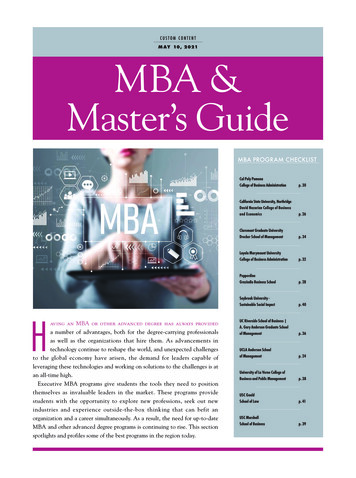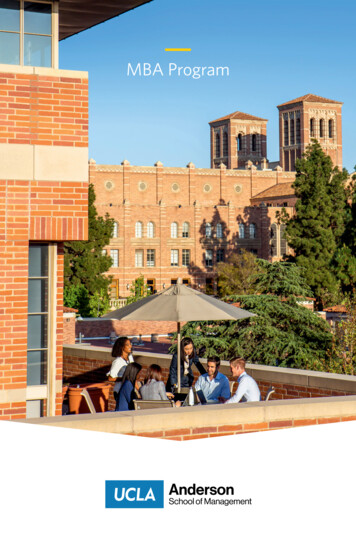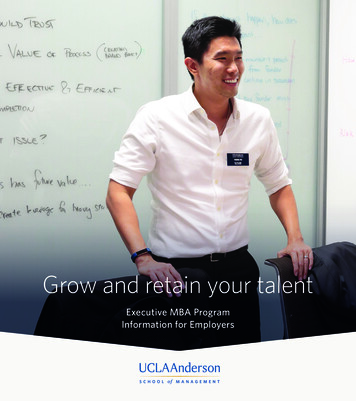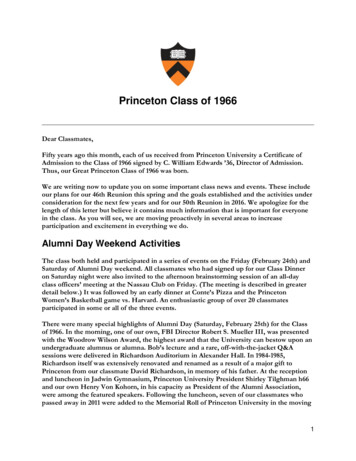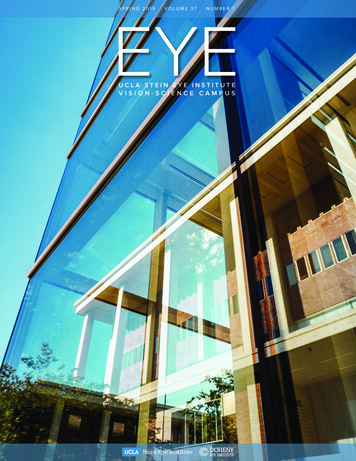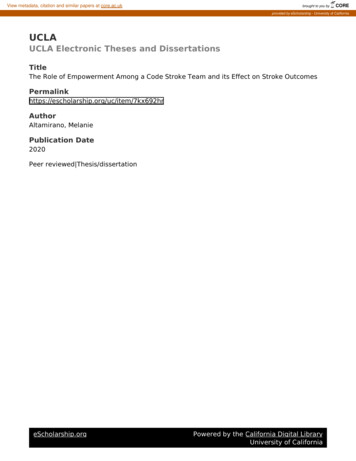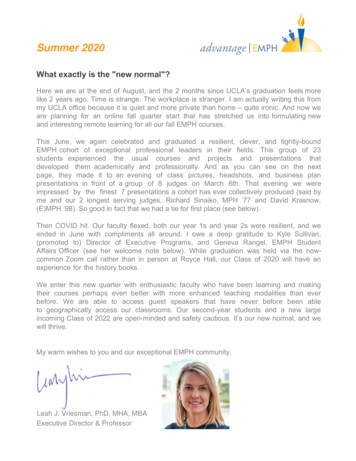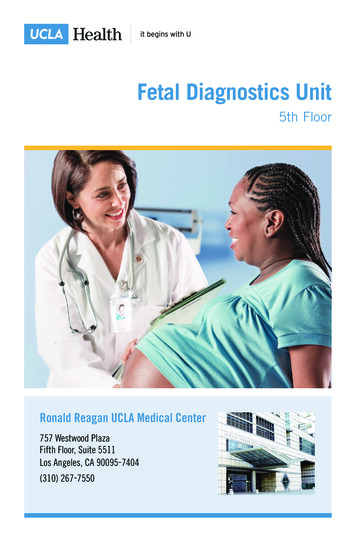
Transcription
Jules Stein Eye Institute401966 - 2006Excellence in VisionEducationPatient CareResearchEYESummer 2006Volume 25, No.2Jules Stein Eye Institute:1966–2006“It is Wonderful to See ”IN 2006, THE JULES STEIN EYE INSTITUTE CELEBRATES THE 40TH ANNIVERSARYof a day in November 1966 when the doors opened and the University of California welcomed thiscomprehensive facility for the care of eye disease, vision-related research and ophthalmic educationon the campus of UCLA.From Concept to RealityNow ranked highly among the world’s leading ophthalmic centers, the Jules Stein EyeInstitute is the fulfillment of a dream, shared by a remarkable physician, businessmanand humanist, Jules Stein, MD, and his wife Doris Stein, of creating a worldrenowned institute dedicated to the preservation of vision and the prevention ofblindness. The planning and building of the Institute was a distinctive collaborationof efforts: conceived by the faculty, endorsed by The UC Regents and built by enlightened philanthropy led by the Steins. On August 18, 1964, with the onset of construction imminent, several hundred scientists, philanthropists and architects—allof whom had helped to create the Institute—enjoyed a festive event and the words ofDr. Stein:“While the tools of modern medicine are extending the lifespan, the rate ofblindness continues its alarming upward climb. The Jules Stein EyeInstitute has been built for people—for the people of today and tomorrow The deepest gratitude will never be expressed. It will be found in theeyes of those who will drink in the beauty of life and will say to themselves,in acknowledgement of this magnificent gift, ‘It is wonderful to see.’ ”It has indeed been wonderful to see—the Institute rising up then, and expanding since. The complexbuilding of research laboratories, innovative operating rooms, patient-friendly clinical areas and computer-equipped classrooms culminated in the original structure of 87,745 square feet within theUCLA Center for the Health Sciences. No less impressive have been the contributions of the finestminds, skills and services in ophthalmology that have built upon the original visionary foundationover four decades.Dedication of Structure and PurposeDedication of the Jules Stein Eye Institute on November 3, 1966, brought University President ClarkKerr, Chancellor Franklin Murphy, Dean Sherman Mellinkoff, Dr. Jules Stein and several thousand donors, clinician-scientists and well-wishers to the joyous Ribbon Cutting by Mrs. Stein and athree-day Inaugural Scientific Program on “The Retina.” At a formal banquet, where 700 friends ofthe Institute wore blindfolds for 60 seconds to personally appreciate the value of vision, Bradley R.Straatsma, MD, Founding Director, compared the advanced attributes of the Institute to the firstacademic institution, Plato’s Academy, founded in the Grove of Academus 2,300 years ago.From concept to reality(from top): Groundbreakingfestivities on September 22,1964; Dr. Jules Stein andFounding Director Dr. BradleyStraatsma; Herald Examinerissue announcing the openingof the Jules Stein Eye Instituteat UCLA on November 3, 1966.
“It is Wonderful to See.”continuedscholarly journals, and as members of various government andprivate foundation scientific advisory panels.FacilitiesClinical areas, laboratories, operating rooms, core equipment andall other facilities of the Institute were purposefully planned tomerge comfort and grace with state-of-the-art resources for patientcare, research and education. In the years after 1966, burgeoningprograms rapidly filled the Institute’s once-ample space. In particular, emerging areas of basic science such as visual biochemistry,neurophysiology and genetics prompted the carving out of another 20,000 square feet from a contiguous parking structure forvision research laboratories, newer equipment and a computerizedlibrary-learning center.“The physical difference between the first academicinstitution, an olive grove, and the most recent, theFour decades of key people and partners(clockwise from top): The JSEI FoundingBoard of Trustees; Dr. Jules Stein with LewWasserman; UCLA ophthalmology leaders:Drs. S. Rodman Irvine (Acting Chief1955–1958, center), Bradley Straatsma(Chief and Chairman 1959–1993, right)and Bartly Mondino (Chairman 1994–Present, left)Jules Stein Eye Institute, is enormous. However, thedifference in principle and purpose is nonexistent. Bothwere founded primarily by private citizens who recognized a need. Both were staffed by academiciansendowed with the ability to ask questions, to poseproblems and to search for answers. The challenge isstill at the boundary of existing knowledge.”The dedication of the structure was matched by dedication ofpurpose and, over the past 40 years, the Jules Stein Eye Institutehas been pushing the boundaries of knowledge by sustaining acontinuum of exciting developments that have made the most ofits tremendous resources of people, facilities and programs.Partnering for SuccessEYEN EWSLETTERIS A PUBLICATIONOF THEJULES STEIN EYE INSTITUTEDIRECTORBartly J. Mondino, MDEDITORSDebora B. Farber, PhD, DPhhcGary N. Holland, MDMANAGING EDITORGloria P. JurisicCONTRIBUTING EDITORSTeresa ClossonNancy GraydonSonia JonesDebbie SatoLori TwitchellMelania VartanianGUEST CONTRIBUTORSCherie HubbellBradley R. Straatsma, MD, JDRuth StraatsmaPHOTOGRAPHYJ. Charles MartinDESIGNRobin Weisz /Graphic DesignPRODUCTION COORDINATIONConiglio & Associatesby The Regents of theUniversity of California.All rights reserved.The University of California partnership with philanthropistsand community leaders, manifested by the construction of theInstitute on the UCLA campus, was formalized in 1977. Thatagreement between Dr. Stein and The UC Regents established theindependent JSEI Board of Trustees, initially: Judge W. MatthewByrne, Jr.; David May II; Chancellor Franklin D. Murphy;Jules Stein, MD; and Bradley R. Straatsma, MD. Currenttrustees: Robert Ahmanson; Bartly J. Mondino, MD; RonaldOlson; Gerald Oppenheimer; Nelson C. Rising; George Smith;Katrina vanden Heuvel and Casey Wasserman, continue thisimportant responsibility by regularly providing valuable oversightand support.www.jsei.orgThe facility was linked to the Jules Stein building with a practicalcolonnade, the architecturally unique Robert Adam Room and theResearch to Prevent Blindness Auditorium. In aggregate, the JulesStein Eye Institute in 2006 provides more than 175,000 squarefeet of core facilities for ophthalmology and vision-related science.ProgramsFrom the beginning, whether in architectural configuration orequipment, the form and facilities of the Institute have been basedupon three core missions: excellence in patient care, research andeducation. The three areas are synergistically effective, each contributing to and benefiting from the others, earning the Jules SteinEye Institute, in a comparatively short time, worldwide respect asa leader and innovator in the field of ophthalmology and thevision sciences.P AT I E N T C A R EThe Institute “ has been built for people,” as Dr. Stein proclaimed, and several million ophthalmic patient examinationsand procedures have been performed at the Institute and UCLAaffiliated programs over the past four decades.Each year, services to patients at the Jules Stein Eye Institute onUCLA’s Westwood Campus include more than 100,000 annualpatient visits, ophthalmic laboratory tests and surgical procedures.Faculty and staff—research scientists, clinician-scientists andspecialists of outstanding quality—responsible for the Institute’sprograms and services have grown in numbers as well as the rangeof disciplines they integrate. From its founding, with Dr.Straatsma as Director (1964–1993) and 11 faculty members:Raymond Allen, MD; Leonard Apt, MD; Robert Christensen,MD; Fredrick Crescitelli, PhD; Michael Hall, PhD; JoramHeller, MD; S. Rodman Irvine, MD; Thomas Pettit, MD; NilesRoth, PhD; Bradley Straatsma, MD; and Richard Young, PhD;the Institute has grown to comprise some 33 Members, nineAssociate Members and 17 Consulting Members led by DirectorDr. Mondino (1994–present).Corresponding growth has occurred in the volunteer faculty,now 213, who hold Clinical Faculty appointments in the UCLADepartment of Ophthalmology and serve as teachers and clinicalspecialists in the Institute’s education and training programs. 2006,Jules Stein Eye Institute100 Stein Plaza, UCLABox 957000Los Angeles, CA 90095–7000(310) 206-6035The crowning event in Institute expansion was the dedication ofthe Doris Stein Eye Research Center on September 21, 1989. Afterher husband’s death in 1981 and before her own in 1984, Mrs.Stein acted on the need for expanded facilities by continuingthe Stein family legacy. Institute trustees, led by Mr. Lew R.Wasserman, The UC Regents and Institute faculty embarked on adesign-build project that resulted in the architecturally compatibleDoris Stein Eye Research Center. It provided more than 67,000square feet for clinical research and patient care areas, the ClinicalResearch Center, an Ophthalmology Imaging Center and basiclaboratories for translational research.The individual and combined accomplishments of Institute faculty have garnered national and worldwide honors: election to theNational Academy of Sciences, the American Academy of Artsand Sciences and the Ophthalmology Hall of Fame. Full-time andvolunteer clinical faculty have also brought recognition to theInstitute as they serve on the National Advisory Eye Council, aselected officers of ophthalmic professional societies, as editors ofThe many faces of patient care(clockwise from top): TheInstitute’s trauma teamperforms a series of surgerieson a child whose eyes had beenseverely injured during the warin Bosnia; JSEI is recognized forits advanced surgical expertise;the Institute extends eye careto the underserved through theUCLA Mobile Eye Clinic
Extending beyond the walls of the Institute are major ophthalmology patient care programs at Los Angeles County’s Harbor—UCLA Medical Center and Olive View—UCLA Medical Center,as well as the Veterans Affairs Greater Los Angeles HealthcareSystem’s West Los Angeles Healthcare Center and SepulvedaMedical Center. Further reaching out into the community areaffiliations with the King Drew Medical Center in Central LosAngeles and the UCLA Mobile Eye Clinic.The growth in numbers—patients, procedures and clinical programs—over the past 40 years has been matched by the tremendous advances in management of eye disease. These encompassan enormous range of comprehensive and subspecialty interventions that reflect the growth in medical knowledge and technology of our era. In 1966, cataract surgery was an inpatient procedure followed by a hospital stay of several days and long-term useof a thick eyeglass or contact lens. Today, it is an outpatient procedure with elective implantation of a multifocal intraocular lens.The availability of lasers to control diabetic retinopathy andcorrect vision, pharmaceutical therapies to manage age-relatedmacular degeneration and computerized models to plan strabismus surgery, are all examples of advances that have dramaticallychanged the way we treat patients with eye disease in 2006.RESEARCHJSEI scientists are currently conducting dozens of basic laboratorystudies and more than 50 IRB-approved clinical trials of therapyfor eye disease. Examples of basic, translational and clinicalinvestigations include: Proteomics relating molecular structure of visual proteins toconformational change that “switches” function and initiatesvision Genomics to determine DNA abnormalities responsible foreye disease Treatment studies on a mouse model of the childhood blindingdisease Stargardt macular degeneration Translation of basic mechanisms for optic nerve disease tomeasurement of optic nerve disease in glaucoma Clinical studies to evaluate cataract surgery-related multifocalintraocular lenses Clinical trials of anti-angiogenesis agents as therapy forage-related macular degeneration (AMD)E D U C AT I O NThe third pillar of the Jules Stein Eye Institute’s programs—education—is provided by the Institute and the Department ofOphthalmology through a continuum of innovative and comprehensive programs for meeting degree and certificate requirements.Education within the Institute since 1966 has involved thousandsof UCLA medical students, hundreds of ophthalmologists whocompleted residency training, and additional hundreds of clinicalophthalmology fellows, and pre- and postdoctoral vision sciencefellows. Beyond these individuals are the incalculable number ofophthalmologists and research scientists who have participated inInstitute programs of continuing professional development.As with the Institute’s other programs, those relating to educationhave grown not only in numbers, but also in their comprehensiveness and range. The ophthalmology program for UCLAmedical student education, an eight to 12-hour Fundamentalsof Clinical Medicine course in the 1960s, is today a phased, fouryear curriculum. The ophthalmology residency program, rankedamong the best in the country, now incorporates the EyeSTAR(Specialty Training and Advanced Research) Program leading to aPhD degree or equivalent expertise for those interested in academic careers and professional leadership as clinician-scientists.Advancing scientific discovery (clockwise from top): The Clinical ResearchCenter (CRC) dedicated in 1998, pictured CRC Director Dr. Gary Holland(right) and JSEI Director Dr. Bartly Mondino (left); a seminal discovery inthe 1960s by JSEI vision scientists, Drs. Richard Young and Dean Bok,shows renewal of the light-sensitive outer segments in retinal photoreceptorcells; JSEI vision scientist Dr. Wayne Hubbell elected to the NationalAcademy of Sciences on May 3, 2005Driving the patient care and education programs at the Instituteis the continuing leadership of its faculty in vision science andclinical research. From the seminal discovery of retinal photoreceptor renewal in the 1960s, to the development of mouse modelsof human retinal degeneration, and new technology for studyingprotein dynamics and function, the Institute’s vision scientistshave been pioneers in emerging fields such as genetics andbiophysics, providing insight into pathogenic mechanisms ofvision-threatening diseases.Bridging its basic research mission and patient care mission arethe Institute’s clinical studies. Over the years, faculty have participated in key clinical investigations—the first report of the ocularmanifestations of AIDS in the 1980s, pivotal studies of diabeticretinopathy, the nationwide Collaborative Ocular MelanomaStudy, and discovery and characterization of the role of extraocular pulleys in eye muscle disease, to name a few. These have madeemerging therapies available to patients and led to improvedmanagement of various ophthalmic problems.The continuum of education at the Institute, including a broadrange of advanced training programs for doctoral, postdoctoraland specialty research fellows, as well as ophthalmologists fromhere and abroad, extends the reach of the Institute’s clinical andresearch excellence throughout the world and into the future.Educating tomorrow’s leaders (clockwisefrom top): Pre- and postdoctoral fellowsbenefit from the Institute’s vision scienceprograms; physicians receive supervisedclinical experience in JSEI’s nationallyrecognized residency program;continuing education programs offeropportunities for practicing ophthalmologists to further their professionaldevelopment
Looking AheadNever in history has medicine been more exciting or infused withgreater promise of benefits. The confluence of molecular biology,medical technology and supercomputer-informatics createsunprecedented opportunities for physicians to enhance the quality of life for patients. The pace of progress is accelerating andUCLA’s Jules Stein Eye Institute, on its 40th anniversary, is wellpositioned for the future with innovative programs of educationfor tomorrow’s leaders, a faculty committed to the full spectrumof basic and clinical research, and an outreach of ophthalmicservices to all sectors of Greater Los Angeles.“The celebration of the 40th Anniversary gives me theopportunity to thank each and every faculty and staffmember for the hard work and dedication, and tothank our community of friends whose commitmentand financial support over these four decades havecontributed to the success of the Jules Stein EyeInstitute. As we look to the future, plans for an additional facility and breakthroughs in clinical and laboratory research promise to elevate the Institute to ahigher level of achievement in eradicating blindnessand preserving vision, and to fulfill Dr. Stein’s dreamA star on the horizon is the eagerly awaited construction (scheduled for 2007) of the Edie and Lew Wasserman Eye ResearchCenter. Named to honor Edie Wasserman and the late LewWasserman, generous benefactors and friends of JSEI, the100,000 square foot facility will be situated opposite to the DorisStein Eye Research Center and form the northern cornerstone ofthe Institute’s vision science plaza. With facilities for advancedeye surgery and gene therapy, vision science research, and synergistic programs relating JSEI to other departments within theDavid Geffen School of Medicine at UCLA, the WassermanCenter will enable faculty to create revolutionary new initiativesthat will dramatically change the way we diagnose, treat, cure andprevent eye disease.for everyone to realize, ‘it is wonderful to see.’”Artist’s rendering of the completed JulesStein Eye Institute campus: From left, theEdie and Lew Wasserman Eye ResearchCenter (construction scheduled for 2007),the Jules Stein Eye Institute building(dedicated in 1966) and the Doris SteinEye Research Center (dedicated in 1989)In just 40 years, the Institute’s comprehensive programs in patientcare, research and education, coupled with its state-of-the artfacilities, have brought national and international recognition tothe Institute and UCLA. Dr. Mondino expresses appreciation forthe generous support extended to the Institute by the Stein familyand many other contributors and pride in its outstanding facultyand staff:EYE LINESUCLA Department of Ophthalmology AssociationUCLA Department ofOphthalmology AssociationT H E UCLA D E PA RT M E N T O FO P H T H A L M O L O G Y A S S O C I AT I O NHISTORY OF OFFICERSCurrent Officers, 2004–2006Robert A. Clark, MD, PresidentKathryn M. Gardner,. MD, Vice-PresidentRobert A. Goldberg, MD, Secretary/TreasurerThe UCLA Department of Ophthalmology Association wasestablished in 1974 to encourage professional interactionamong its members, to support the academic programs of theDepartment of Ophthalmology and the Jules Stein Eye Institute,and to promote the advancement of ophthalmic science.Past PresidentsThe Association includes all members of the faculty of theUCLA Department of Ophthalmology, current and formerresidents and fellows of the Department of Ophthalmologyprograms, as well as honorary members. Annual Associationdues support: the annual Research Grant Awards for JSEI Residentsand Fellows the JSEI Clinical and Research Seminar that takes placeseach spring the Video Library Project the Alumni Reception at the Annual AAO Meeting other important alumni networking eventsAssociation membership has grown exponentially over theyears, boasting a current membership of more than 600 alumnidating back to the opening of the Institute in 1966. Located in26 different countries throughout the world, JSEI residents andfellows have had a global impact in the field of ophthalmology.Most of the international fellows who train at the Jules Stein EyeInstitute return to their country of origin to practice and teachothers. Several have gone on to become leaders in their field anddirectors of Departments where they practice and teach.First graduating class (inclusive of faculty) on the steps of the newlyconstructed Jules Stein Eye Institute, Class of 1967—First row (left to right):Drs. Harold B. Alexander, Thomas H. Pettit, Robert E. Christensen, Bradley R.Straatsma, Robert E. Bartlett; Second row: Drs. Leland M. Garrison, Allan E.Kreiger, Richard N. Learn, Maurice B. Landers, Knute Guldjord, Dennis D.Shepard; Third row: Drs. Bruce J. Lenartz, Alan L. Susal, Harry S. Brown,Phillip N. Hale, George B. Miller, John R. Hushaw; Fourth row: Drs. Stephen N.Hull, Kenneth L. Westbrook, James P. McDonald, John D. Slaney. Not shownare faculty members Drs. Leonard Apt and Robert S. Hepler.Peter J. Cornell, MD, 2002–2004Norman Shorr, MD, 2000–2002Lynn K. Gordon, MD, PhD, 1999–2000Norman Shorr, MD, 1998–1999Stanley M. Kopelow, MD, 1997–1998Alan L. Shabo, MD, 1996–1997Barry M. Kerman, MD, 1995–1996Howard R. Krauss, MD, 1994–1995George M. Rajacich, MD, 1993–1994Edwin P. Hill, MD, 1992–1993James W. McKinzie, MD, 1991–1992Stephen R. Seiff, MD, 1989–1991Robert E. Bartlett, MD, 1988–1989Sidney W. Penn, MD, 1987–1988Gerald S. Sanders, MD, 1986–1987Howard H. Stone, MD, 1985–1986Donald E. Dickerson, MD, 1984–1985Jack Fields, MD, 1983–1984Richard Elander, MD, 1982–1983David D. Michaels, MD, 1981–1982Henry I. Baylis, MD, 1980–1981C. Richard Hulquist, MD, 1979–1980Roger W. Sorenson, MD, 1978–1979Sherwin H. Sloan, MD, 1977–1978George B. Primbs, MD, 1976–1977Irvin S. Pilger, MD, 1975–1976S. Rodman Irvine, MD, 1974–1975
Co m m u n i t yOu t r e a c hFour Decades of Reaching Out to the CommunitySProfessor Emeritus Dr.Leonard Apt (center),Director and MedicalAdvisor of the PreschoolVision Screening Program,and Pam Berg (left),former JSEI orthoptist,administer a visionscreening test topreschoolers.ince the Dedication of the Jules Stein Eye Institute in 1966, faculty, staff,residents, fellows and volunteers have reached out to provide basic eye careservices to underserved populations in Los Angeles and beyond. Various outreach programs have been initiated by the Institute’s volunteer organization, theJSEI Affiliates, as well as committed donors and Institute doctors who generously offer their time and resources to give back to the community.JSEI AffiliatesThe JSEI Affiliates, a network of community volunteers, was initiated 15 yearsago to support the programs of the Institute and to promote vision educationand patient care in schools and throughout the Los Angeles community. Initiallylaunched by a handful of dedicated volunteers, the JSEI Affiliates now boasts aroster of 180 members, 42 volunteers and an 18 person advisory board.strain on families. Through financial support from The Annenberg Foundation,approximately 40 children per year benefit from this fund with several hundredcontact lenses distributed since its inception.T ELEMEDICINE P ROGRAMJSEI Affiliates (left to right) Co-Presidents Cherie Hubbell and Marti Oppenheimer, and FoundingPresident Ruth StraatsmaOver the years, the Affiliates have built a collection of diverse and far-reachingprograms. Educating children about one of their most precious assets—theireyes—the Affiliates offer the Vision In-School Program and Preschool VisionScreenings free of charge to elementary schools and preschools in the community. The Affiliates also support several patient programs. Make Surgery Bearablehas provided thousands of Dr. Teddy MD teddy bears to pediatric surgerypatients at JSEI, while Shared Vision has collected over 10,000 pairs of donatedeyeglasses to be refurbished and distributed to adults and children who couldnot otherwise afford them. The MagniVision program provides financial andvolunteer support to the Institute’s Vision Rehabilitation Center, which housesa lending library of low vision aids to JSEI’s visually challenged patients.Special Donors Make a DifferenceThe Jules Stein Eye Institute, in partnership with the Venice Family Clinic (VFC),is using telemedicine to prevent long-term visual loss by screening for eye disease indiabetic patients. The program connects volunteer eye specialists in JSEI’s RetinaDivision to the clinic’s patients by way of a Virtual Private Network. Digital retinalphotographs taken by VFC staff as part of the normal diabetes examination arestored on its server. The retina team accesses the digital images via a network connection at JSEI, entering clinical impressions directly into the clinic’s computer. VFCtreats 1,500 patients with diabetes. Patients typically have no insurance and subsiston incomes of 18,200 for a family of four.UCLA M OBILE E YE C LINICThe UCLA Mobile Eye Clinic has been providing free eye examinations to underserved populations in Southern California for 30 years. Donated by Uncle Claude,Inc., and supported by The Karl Kirchgessner Foundation, it is funded entirely byprivate donations. The Clinic—a specially equipped bus with a staff of ophthalmologists, technicians, residents and volunteers—visits community locations servinglow-income families and the homeless. Eye examinations are performed to determinethe need for prescriptive lenses and to rule out the need for further eye treatment. Ina typical year, close to 4,000 children and 1,000 adults are examined. The AnnenbergFoundation and other private donors have made it possible for individuals withoutthe means of receiving prescribed eye care to obtain surgery and/or outpatient servicesat the Jules Stein Eye Institute. Corrective lenses are also provided free of charge tochildren who qualify, through a voucher program with local opticians.I NDIGENT FAMILIES P ROGRAMDr. Robert Christensen,the late former Vice-Chairof the Department ofOphthalmology and Chiefof the Glaucoma Division,was the FoundingDirector of the MobileEye Clinic (1975–1990).The Indigent Families Program provides ophthalmic surgical procedures foreconomically disadvantaged members of our community who have no medicalinsurance coverage. Patients are referred by JSEI fellows and residents throughUCLA-affiliated programs. With support from The Annenberg Foundation anddiscounted rates from UCLA Medical Center and the Department of Anesthesiology, essential eye surgeries for potentially vision-threatening conditions areperformed for patients who have no other alternatives for medical care.I NDIGENT C HILDREN ’ S P ROGRAMThe Indigent Children’s Program enables JSEI to provide surgical ophthalmicservices to economically disadvantaged youth free of charge thanks to thefinancial support from The Annenberg Foundation and the L. & S. MilkenFoundation. Coordinated by the Institute’s Pediatric Ophthalmology andStrabismus Division, the program relies on physicians and nurses from localhealth centers and urban schools to identify children in need of eye surgery,who do not have medical insurance to cover such costs.P EDIATRIC C ONTACT L ENS F UNDThe Pediatric Contact Lens Fund helps pay for contact lenses for children underfive years of age, who suffer from congenital and infantile cataracts. Because children grow rapidly and their corneas can change shape frequently, providing custom-made contact lenses throughout this growth period can cause great financialJSEI’s Doctors Make a DifferenceThe majority of JSEI’s community outreach programs would not be possible withoutthe commitment of the Institute’s incredible team of physicians, nurses, residents andfellows who volunteer to make these programs a reality. Many of the surgical procedures for the Indigent Families and Children’s Programs are donated free of charge bythe surgeons or performed at a deeply discounted rate. In addition to supporting theInstitute’s outreach programs in the greater Los Angeles area, several JSEI facultymembers, residents and fellows participate in or organize clinic missions around theworld to help the visually impaired in economically disadvantaged countries.
researchers with crucial funding for their projects. Through theJules and Doris Stein UCLA Support Group, Gail and Jerry willalso spearhead the fund-raising efforts for the Wasserman Center.HILANTHROPYCONTINUING THE STEINS’PHILANTHROPIC SPIRITThe Jules Stein Eye Institute was established 40 years ago asthe result of the philanthropy and vision of the late Dr. andMrs. Jules Stein. Together, this remarkable couple created alegacy for vision research, education and patient care. Theirinterest, as well as their emotional and financial investment inophthalmology, continues today with the involvement of theirfamily and friends. The Steins’ daughter, Jean Stein, has been aloyal supporter of the Institute’s programs and is a Partner in theplanned construction of the new Edie and Lew Wasserman EyeResearch Center. Jean’s daughter, Katrina vanden Heuvel, also aPartner in the new building, has served on the Institute’s Board ofTrustees since 1984.Gerald Oppenheimer, son of Doris Stein, and his wife Gailremain actively involved. Jerry serves on the Institute’s Boardof Trustees and established the Gerald Oppenheimer FamilyFoundation Center for the Prevention of Eye Disease in 2003.In addition, he established the Stein/Oppenheimer Awards, aprogram that has provided more than 180 UCLA biomedicalFocus onPThe Oppenheimers (left to right) at the 2001 Reflections Gala: Megan, Luke,Gabrielle, Tony, Reed, Marti, Eric Jr., Jami, Sophie and Brian.Wasserman family (left to right): Carol Ann Leif, Lynne, Casey,Edie and Lew WassermanDevelopment OfficeJules Stein Eye Institute100 Stein Plaza, UCLABox 957000Los Angeles, California90095–7000(310) 206-6035giving@jsei.ucla.eduThe late Lew Wasserman succeeded Jules Stein not only in business, but also in philanthropy. Lew served as Chairman of MCA,Inc., as well as Chairman of Research to Prevent Blindness and asa founding member of the Jules Stein Eye Institute’s Board ofTrustees. His grandson, Casey Wasserman, continues the familytradition and has served on the Board since 1998. The WassermanFoundation, along with funds from the Stein estate and the Julesand Doris Stein UCLA Support Group, will underwrite the capitalportion of the new Wasserman Center.Dr. and Mrs. Stein would be proud to know that they lau
EYE Summer 2006 Volume 25,No.2 Jules Stein Eye Institute IN 2006, THE JULES STEIN EYE INSTITUTE CELEBRATES THE 40TH ANNIVERSARY of a day in November 1966 when the doors opened and the University of California welcomed this comprehensive facility for the care of eye disease, vision-related research and ophthalmic education on the campus of UCLA.

